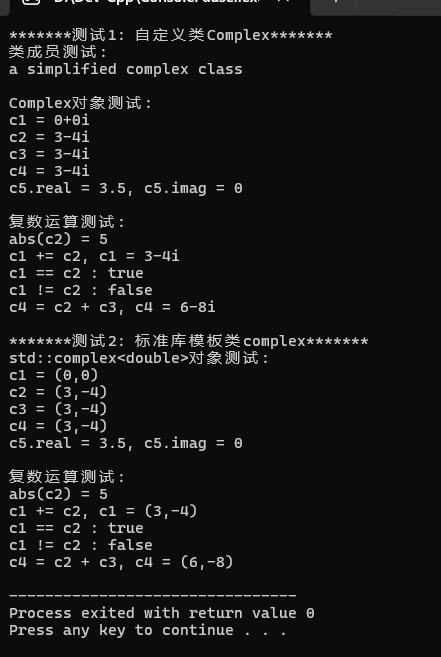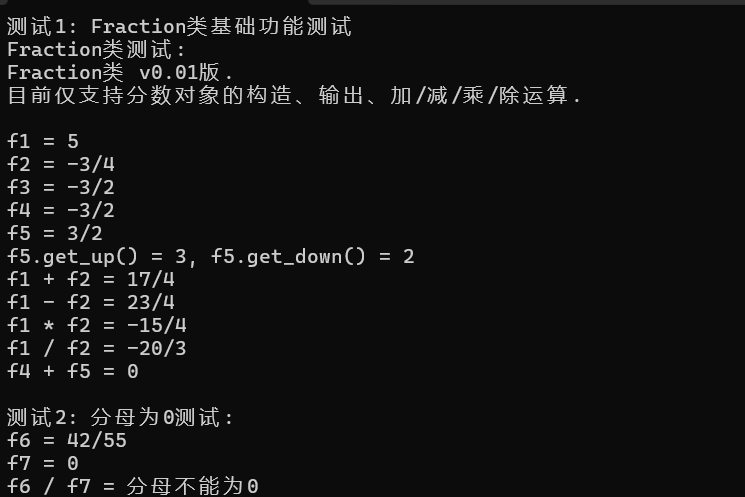实验二
实验任务一:
代码
T.h
点击查看代码
#pragma once
#include <string>
class T
{
public:
T(int x = 0, int y = 0);
T(const T &t);
T(T &&t);
~T();
void adjust(int ratio);
void display() const;
private:
int m1, m2;
public:
static int get_cnt();
public:
static const std::string doc;
static const int max_cnt;
private:
static int cnt;
friend void func();
};
void func();
T.cpp
点击查看代码
#include "T.h"
#include <iostream>
#include <string>
const std::string T::doc{"a simple class sample"};
const int T::max_cnt = 999;
int T::cnt = 0;
int T::get_cnt()
{
return cnt;
}
T::T(int x, int y): m1{x}, m2{y}
{
++cnt;
std::cout << "T constructor called.\n";
}
T::T(const T &t): m1{t.m1}, m2{t.m2}
{
++cnt;
std::cout << "T copy constructor called.\n";
}
T::T(T &&t): m1{t.m1}, m2{t.m2}
{
++cnt;
std::cout << "T move constructor called.\n";
}
T::~T()
{
--cnt;
std::cout << "T destructor called.\n";
}
void T::adjust(int ratio)
{
m1 *= ratio;
m2 *= ratio;
}
void T::display() const
{
std::cout << "(" << m1 << ", " << m2 << ")" ;
}
void func()
{
T t5(42);
t5.m2 = 2049;
std::cout << "t5 = "; t5.display();
std::cout << '\n';
std::cout<<"func:T objects'current count:"<<T::get_cnt()<<'\n';
}
task1.cpp
点击查看代码
#include "T.h"
#include <iostream>
void test_T();
int main()
{
std::cout << "test Class T: \n";
test_T();
std::cout << "\ntest friend func: \n";
func();
}
void test_T()
{
using std::cout;
using std::endl;
cout << "T info: " << T::doc << endl;
cout << "T objects'max count: " << T::max_cnt << endl;
cout << "T objects'current count: " << T::get_cnt() << endl << endl;
T t1;
cout << "t1 = "; t1.display(); cout << endl;
T t2(3, 4);
cout << "t2 = "; t2.display(); cout << endl;
T t3(t2);
t3.adjust(2);
cout << "t3 = "; t3.display(); cout << endl;
T t4(std::move(t2));
cout << "t4 = "; t4.display(); cout << endl;
cout << "test: T objects'current count: " << T::get_cnt() << endl;
}
结果:

问题1:YES。
问题2:普通构造函数是将对象初始化,如果为给定值时,使用函数中默认的值;在给对象初始化时使用。复制构造函数是将已定义好的对象复制给一个新对象并运用函数;在要使用和已定义好的对象相等的新对象时使用。移动构造函数是将已定义好的对象里的值转移给新的对象,原对象里的值变为空;在要使用和已定义好的对象相等的新对象,并且不再需要原对象时使用。析构函数是在此类函数调用结束后释放内存;在类函数调用完毕时使用。
问题3:能。
实验任务二:
代码
Complex.h
点击查看代码
#pragma once
#include <string>
class Complex
{
public:
const static std::string doc;
Complex(double x=0,double y=0);
Complex(const Complex &c);
~Complex();
double get_real() const;
double get_imag() const;
void add(const Complex &c);
private:
double real,imag;
friend void output(const Complex &c);
friend double abs(const Complex &c);
friend Complex add(const Complex &c1,const Complex &c2);
friend bool is_equal(const Complex &c1,const Complex &c2);
friend bool is_not_equal(const Complex &c1,const Complex &c2);
};
void output(const Complex &c);
double abs(const Complex &c);
Complex add(const Complex &c1,const Complex &c2);
bool is_equal(const Complex &c1,const Complex &c2);
bool is_not_equal(const Complex &c1,const Complex &c2);
Complex.cpp
点击查看代码
#include"Complex.h"
#include<iostream>
#include<string>
#include<cmath>
const std::string Complex::doc{"a simplified complex class"};
double Complex::get_real() const
{
return real;
}
double Complex::get_imag() const
{
return imag;
}
Complex::Complex(double x,double y):real{x},imag{y}
{
}
Complex::Complex(const Complex &c):real{c.real},imag{c.imag}
{
}
Complex::~Complex()
{
}
void Complex::add(const Complex &c)
{
real+=c.real;
imag+=c.imag;
}
void output(const Complex &c)
{
if(c.imag>=0)
{
std::cout<<c.real<<"+"<<c.imag<<"i";
}
else
{
std::cout<<c.real<<c.imag<<"i";
}
}
double abs(const Complex &c)
{
return std::sqrt(c.real*c.real+c.imag*c.imag);
}
Complex add(const Complex &c1,const Complex &c2)
{
return Complex(c1.real+c2.real,c1.imag+c2.imag);
}
bool is_equal(const Complex &c1,const Complex &c2)
{
return (c1.real==c2.real&&c1.imag==c2.imag);
}
bool is_not_equal(const Complex &c1,const Complex &c2)
{
return (c1.real!=c2.real||c1.imag!=c2.imag);
}
task2.cpp
点击查看代码
#include"D:\qq\实验2文档部分代码\task1\Complex.h"
#include <iostream>
#include <iomanip>
#include <complex>
void test_Complex();
void test_std_complex();
int main() {
std::cout << "*******测试1: 自定义类Complex*******\n";
test_Complex();
std::cout << "\n*******测试2: 标准库模板类complex*******\n";
test_std_complex();
}
void test_Complex() {
using std::cout;
using std::endl;
using std::boolalpha;
cout << "类成员测试: " << endl;
cout << Complex::doc << endl << endl;
cout << "Complex对象测试: " << endl;
Complex c1;
Complex c2(3, -4);
Complex c3(c2);
Complex c4 = c2;
const Complex c5(3.5);
cout << "c1 = "; output(c1); cout << endl;
cout << "c2 = "; output(c2); cout << endl;
cout << "c3 = "; output(c3); cout << endl;
cout << "c4 = "; output(c4); cout << endl;
cout << "c5.real = " << c5.get_real()
<< ", c5.imag = " << c5.get_imag() << endl << endl;
cout << "复数运算测试: " << endl;
cout << "abs(c2) = " << abs(c2) << endl;
c1.add(c2);
cout << "c1 += c2, c1 = "; output(c1); cout << endl;
cout << boolalpha;
cout << "c1 == c2 : " << is_equal(c1, c2) << endl;
cout << "c1 != c2 : " << is_not_equal(c1, c2) << endl;
c4 = add(c2, c3);
cout << "c4 = c2 + c3, c4 = "; output(c4); cout << endl;
}
void test_std_complex() {
using std::cout;
using std::endl;
using std::boolalpha;
cout << "std::complex<double>对象测试: " << endl;
std::complex<double> c1;
std::complex<double> c2(3, -4);
std::complex<double> c3(c2);
std::complex<double> c4 = c2;
const std::complex<double> c5(3.5);
cout << "c1 = " << c1 << endl;
cout << "c2 = " << c2 << endl;
cout << "c3 = " << c3 << endl;
cout << "c4 = " << c4 << endl;
cout << "c5.real = " << c5.real()
<< ", c5.imag = " << c5.imag() << endl << endl;
cout << "复数运算测试: " << endl;
cout << "abs(c2) = " << abs(c2) << endl;
c1 += c2;
cout << "c1 += c2, c1 = " << c1 << endl;
cout << boolalpha;
cout << "c1 == c2 : " << (c1 == c2)<< endl;
cout << "c1 != c2 : " << (c1 != c2) << endl;
c4 = c2 + c3;
cout << "c4 = c2 + c3, c4 = " << c4 << endl;
}
结果:

问题一:自定义类更简洁,有。
问题二:
2-1:需要,因为他们都需要在访问私有数据realh和imag后才能输出数据。
2-2:否。
2-3:一个函数在使用时需要使用类中的私有数据。
问题三:Complex(const Complex &c)=delete
实验任务三:
代码
PlayerControl.h
点击查看代码
#pragma once
#include <string>
enum class ControlType {Play, Pause, Next, Prev, Stop, Unknown};
class PlayerControl {
public:
PlayerControl();
ControlType parse(const std::string& control_str); // 实现std::string --> ControlType转换
void execute(ControlType cmd) const; // 执行控制操作(以打印输出模拟)
static int get_cnt();
private:
static int total_cnt;
};
PlayerControl.cpp
点击查看代码
#include "PlayerControl.h"
#include <iostream>
#include <algorithm>
#include<cctype>
int PlayerControl::total_cnt = 0;
PlayerControl::PlayerControl() {}
// 待补足
// 1. 将输入字符串转为小写,实现大小写不敏感
// 2. 匹配"play"/"pause"/"next"/"prev"/"stop"并返回对应枚举
// 3. 未匹配的字符串返回ControlType::Unknown
// 4. 每次成功调用parse时递增total_cnt
ControlType PlayerControl::parse(const std::string& control_str)
{
std::string s=control_str;
std::transform(s.begin(),s.end(),s.begin(),[](unsigned char c){return std::tolower(c);});
ControlType cmd=ControlType::Unknown;
if(s=="play")
{
cmd=ControlType::Play;
total_cnt++;
}
else if(s=="pause")
{
cmd=ControlType::Pause;
total_cnt++;
}
else if(s=="next")
{
cmd=ControlType::Next;
total_cnt++;
}
else if(s=="prev")
{
cmd=ControlType::Prev;
total_cnt++;
}
else if(s=="stop")
{
cmd=ControlType::Stop;
total_cnt++;
}
return cmd;
}
void PlayerControl::execute(ControlType cmd) const {
switch (cmd) {
case ControlType::Play: std::cout << "[play] Playing music...\n"; break;
case ControlType::Pause: std::cout << "[Pause] Music paused\n"; break;
case ControlType::Next: std::cout << "[Next] Skipping to next track\n"; break;
case ControlType::Prev: std::cout << "[Prev] Back to previous track\n"; break;
case ControlType::Stop: std::cout << "[Stop] Music stopped\n"; break;
default: std::cout << "[Error] unknown control\n"; break;
}
}
int PlayerControl::get_cnt() {
return total_cnt;
}
task3.cpp
点击查看代码
#include "PlayerControl.h"
#include <iostream>
void test() {
PlayerControl controller;
std::string control_str;
std::cout << "Enter Control: (play/pause/next/prev/stop/quit):\n";
while(std::cin >> control_str) {
if(control_str == "quit")
break;
ControlType cmd = controller.parse(control_str);
controller.execute(cmd);
std::cout << "Current Player control: " << PlayerControl::get_cnt() << "\n\n";
}
}
int main() {
test();
}
结果:

实验任务四:
代码
Fraction.h
点击查看代码
#pragma once
#include <string>
class Fraction
{
private:
int up, down;
public:
static const std::string doc;
Fraction(int x, int y = 1);
Fraction(const Fraction &t);
~Fraction() = default;
int get_up() const;
int get_down() const;
Fraction negative() const;
void simplify();
static int gcd(int a, int b);
friend void output(const Fraction &f);
friend Fraction add(const Fraction &f1, const Fraction &f2);
friend Fraction sub(const Fraction &f1, const Fraction &f2);
friend Fraction mul(const Fraction &f1, const Fraction &f2);
friend Fraction div(const Fraction &f1, const Fraction &f2);
};
void output(const Fraction &f);
Fraction add(const Fraction &f1, const Fraction &f2);
Fraction sub(const Fraction &f1, const Fraction &f2);
Fraction mul(const Fraction &f1, const Fraction &f2);
Fraction div(const Fraction &f1, const Fraction &f2);
Fraction.cpp
点击查看代码
#include "Fraction.h"
#include <iostream>
#include <cstdlib>
const std::string Fraction::doc{"Fraction类 v0.01版.\n目前仅支持分数对象的构造、输出、加/减/乘/除运算."};
Fraction::Fraction(int x, int y) : up(x), down(y)
{
simplify();
}
Fraction::Fraction(const Fraction &t) : up(t.up), down(t.down) {}
int Fraction::get_up() const
{
return up;
}
int Fraction::get_down() const
{
return down;
}
Fraction Fraction::negative() const
{
return Fraction(-up, down);
}
int Fraction::gcd(int a, int b)
{
return b==0?a:gcd(b,a%b);
}
void Fraction::simplify()
{
if (down < 0)
{
up = -up;
down = -down;
}
int g = gcd(std::abs(up), std::abs(down));
if (g != 0)
{
up/= g;
down/= g;
}
}
void output(const Fraction &f)
{
if (f.up == 0)
{
std::cout << "0";
return;
}
if (f.down == 1)
{
std::cout << f.up;
return;
}
std::cout << f.up << "/" << f.down;
}
Fraction add(const Fraction &f1, const Fraction &f2)
{
int numerator = f1.up * f2.down + f2.up * f1.down;
int denominator = f1.down * f2.down;
return Fraction(numerator, denominator);
}
Fraction sub(const Fraction &f1, const Fraction &f2)
{
int numerator = f1.up * f2.down - f2.up * f1.down;
int denominator = f1.down * f2.down;
return Fraction(numerator, denominator);
}
Fraction mul(const Fraction &f1, const Fraction &f2)
{
return Fraction(f1.up * f2.up, f1.down * f2.down);
}
Fraction div(const Fraction &f1, const Fraction &f2)
{
if (f2.up == 0)
{
std::cout << "分母不能为0\n";
return Fraction(0, 1);
}
return Fraction(f1.up * f2.down, f1.down * f2.up);
}
task4.cpp
点击查看代码
#include "Fraction.h"
#include <iostream>
void test1();
void test2();
int main() {
std::cout << "测试1: Fraction类基础功能测试\n";
test1();
std::cout << "\n测试2: 分母为0测试: \n";
test2();
}
void test1() {
using std::cout;
using std::endl;
cout << "Fraction类测试: " << endl;
cout << Fraction::doc << endl << endl;
Fraction f1(5);
Fraction f2(3, -4), f3(-18, 12);
Fraction f4(f3);
cout << "f1 = "; output(f1); cout << endl;
cout << "f2 = "; output(f2); cout << endl;
cout << "f3 = "; output(f3); cout << endl;
cout << "f4 = "; output(f4); cout << endl;
const Fraction f5(f4.negative());
cout << "f5 = "; output(f5); cout << endl;
cout << "f5.get_up() = " << f5.get_up()
<< ", f5.get_down() = " << f5.get_down() << endl;
cout << "f1 + f2 = "; output(add(f1, f2)); cout << endl;
cout << "f1 - f2 = "; output(sub(f1, f2)); cout << endl;
cout << "f1 * f2 = "; output(mul(f1, f2)); cout << endl;
cout << "f1 / f2 = "; output(div(f1, f2)); cout << endl;
cout << "f4 + f5 = "; output(add(f4, f5)); cout << endl;
}
void test2() {
using std::cout;
using std::endl;
Fraction f6(42, 55), f7(0, 3);
cout << "f6 = "; output(f6); cout << endl;
cout << "f7 = "; output(f7); cout << endl;
cout << "f6 / f7 = "; output(div(f6, f7)); cout << endl;
}
结果:

问题:友元,方便直接访问私有数据。




 浙公网安备 33010602011771号
浙公网安备 33010602011771号